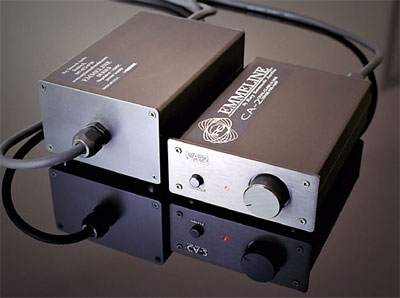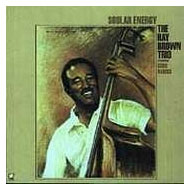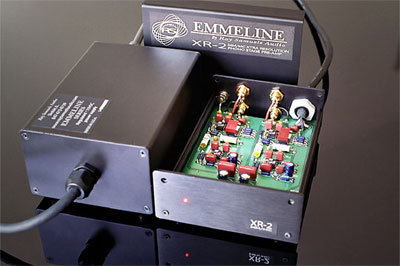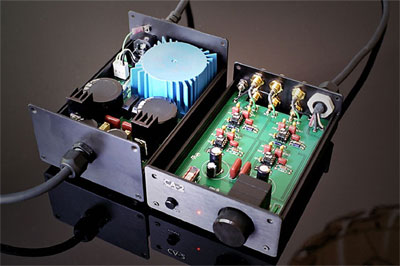|
You are reading the older HTML site Positive Feedback ISSUE 10october/november 2003
ray samuels audio Emmeline CA-2 line stage and XR-2 phono stage as reviewed by Mike Peshkin and Mike Malter
|
||
|
|
That "instrumental moment" can be the complex sound of a French horn or violin, or as simple as the chimes used as accent in many different pieces of music. When that moment of reality strikes, it is jarring. Would that our sound systems could do that with all instruments, all notes. Alas, they can’t, but a good system’s sound and the way it reproduces music is a wonder and a gift only a few of us know, and that is sad. I had a friend over this past weekend that has always thought my obsession with good sound was foolish. We were listening to a jazz record he knew quite well, and he turned to me and said, "It’s amazing how different the same record can sound on different equipment!" I almost passed out! Here’s a guy that has spent a small fortune on equipment that would cause most audio nuts to turn up their noses, and who has frequently stated that there was absolutely no sonic difference, telling me that there WAS, in fact, a difference! I’d always been a bit miffed because he’d never asked advice when he bought his receiver, speakers, and the plastic horror he plays LPs upon. (Ya gotta remember that this is a guy whose children I was the first—outside of the parents of course—to hold at the hospital when they were born, and he, too, was the first to hold my children. We’ve been close friends for a very long time.) On that occasion, we were listening to the Samuels Emmeline XR-2 phono stage and CA-2 line stage preamp. They are tiny. The line stage has but two inputs, perfect for someone like me who listens to both LPs and CDs. Both units have outboard power supplies attached by long umbilical cords. I set the power supplies on the floor with heavy wood blocks beneath them. I attached everything with my Red Dragon silver interconnects, and used stock power cords into the IEC connectors on the power supplies. I listened to the phono stage through my tubed Anthem Pre1 for a week before rerouting everything and using the Samuels line stage. The sound through my tubed pre was similar to (but not as bad) as lousy digital sound—thin, with a shallow, between-the-speaker soundstage. One thing that really bugged me was the POP that I heard on almost all vocals. Aspirated bi-labials (linguistic description for the letter "P") sounded like every singer had their lips too close to the mike when singing. The unit also picked up the sound of my refrigerator kicking on in a not-so-friendly manner. I wonder if those two popping sounds are related in some electronic fashion? Earlier I wrote of moments that surprise you while listening. There is a single chime on the song "Charley Freak" from Steely Dan’s Pretzel Logic (ABCD 808), after the lyrics, "…while he sighed, his body died in fifteen ways." The sound of that chime was so clear and sharp through the Samuels that I stood up and played it once again because I was so impressed with its realism. The crowd noises on "Ruby, Ruby" were so clear I could almost listen to individual conversations! Male vocals were rendered well through the Samuels, but there was that same underlying discomfort that I hear with poorly recorded CDs. While listening to The Nightfly (WB23696-1), I had to turn the volume down because of that upper midrange harshness. This is a pop LP with a rather deep and wide soundstage—at least it is through anything I’ve ever had attached to the Infinitys. Not so with the Samuels phono stage, at least through the Anthem. But those male vocals! On Joe Turner and Pete Johnson (Emarcy MG36014), it was like they were given elocution lessons! It could be taken as a negative that the sound changed the delivery and the recording, but that’s not what I mean. Everything sounded a bit clearer and easier to understand. One of the most exciting things when listening to music is hearing "the big engine" revving up and delivering sound with fury attached. The opening of Brahms Double Concerto on RCA LSC2513 is full-bodied and awe-inspiring through my preamp, but not so through the Samuels. "Laid back with no power" is what I wrote in my notes. Unforgivable! My Dynavector 20X cartridge is pretty good at separating instruments—perhaps not as good as the Glider, but no slouch—but the sound of the orchestra on the Brahms was, unfortunately, homogenized. It’s important to note that while I was ready with a pair of tiny transformers to boost the low output of the 20X, the Samuels had more than enough gain, so those Sony transformers stayed in the little bowl I keep them in. Then I decided to detach my preamp and attach the Samuels line stage. Different story, folks! I was impressed with how quiet the phono stage was through my tube preamp, but quiet with my preamp and quiet with the Samuels line stage were two different animals. Out-of-phase clicks and pops were rejected beautifully. Replaying the concerto, there was more power from the orchestra. Even more importantly, the sound of the cello and violin was clear and separate. No homogeny there!
The piano on "Queen of the Slipstream" on Van Morrison’s Poetic Champions Compose (Polygram 832585) made me do one of those sit-up-and-take-notice things I spoke of in the beginning of this report. "More flesh!" is how I described it in my notes. The harmonica in "The Mystery" can sound muffled on so many systems, but it was clear and bright with the Samuels. The midrange with the Samuels phono stage/preamp pair was so smooth and mellow it made me want a good chocolate truffle! I think a lot of people would say my system is too warm, and perhaps that is the quibble I have with the Samuels preamps. Their sound is closer to the analytical, yet they are quite warm. The biggest fault I found was the lack of extension at both the bottom and top end.
Through my Audio Alchemy CD player, there was some butt shattering, but not of the heart-stopping variety my Anthem achieves. I heard the same vocal clarity on Bonga ‘72 (Tinder 42846642) that I’d heard on LP. I like to use this CD because the guiro ("scratcher") sound always shows me how a piece of equipment handles attacks—the sound being, in essence, a series of attacks. The Samuels, while not the equal to the Anthem, sounded fine, but I did learn something. I do not have heaven here at the Peshkin abode. I possess no listening room, so my living room is the listening room. I always cover the TV with a heavy blanket, and when I listened to Bonga without it, the guiro sounded more like a shaker than a scratcher. Two pieces of wood turned into a gourd with seeds inside! I covered the TV and those pieces of wood returned.
There are newer CDs I could have chosen to listen to, and I apologize to those who want to read about what is more current, but I find less and less music that I want to buy every time I visit any store. Therefore, I chose Stereophile’s ’95 recording Festival (STPH007-2) as an orchestral piece. I won’t dwell too long on this one, except to say that it made my thoughts on this preamp coalesce. Once again, I heard separate instruments playing together rather than the homogenized sound I’d accused the Samuels of when connected to my own preamp. I wondered whether my love for tube sound flavored my response to this piece of gear, and I think it did in many ways. Does it lack extension in the top and bottom of the audio spectrum? To my ears, yes. Does the thing play music in a satisfying way? If you like vocals, you’ll love this. I can’t think of any piece of gear I’ve heard recently that gets the midrange as perfectly, but that lack of extension sticks in my throat, gets under my fingernails, does nasty things, yet I have to admit that maybe, just maybe, this thing is correct and my tube gear is bloated. I’ll take tubes anyway, thank you. Mike Peshkin
|
|
|
|
On the flip side, I sometimes found the sound produced by the combined pieces to be lacking in extension and edgy. I could never escape digital glare with either CDs or SACDs. When the volume on the preamp was up (or during crescendos), the sound frequently became etched. Bass was tight, but never really fulfilling. Compared to my in-house gear, the XR-2 phono stage was much more revealing and musical than my Creek OBH-8 phono stage, but not as revealing, musical, or refined as my tubed Granite Audio phono stage, which is over four times the price. The CA-2 line stage sounded similar to my Parasound AVC 2500u, but again not as musical or refined as my reference tubed Granite Audio preamp.
The XR-2 consists of two pieces, one containing the phono stage and the other a power supply connected by a shielded 5.5 umbilical. Both are anodized aluminum. The XR-2 offers a lot of built-in flexibility. It supports both MM and MC cartridges. To set the impedance for your cartridge, you adjust a micro switch for the following settings: 47K, 470, 100, 80, 50 or 30 ohms. A location is also provided for adding any value resistor, if none of the settings work for you. You will not need a meter for most settings, and if you have an esoteric cartridge that needs a special setting, you are covered. All resistors are film, of .1% tolerance, and all caps are polypropylene and polycarbonate. They are matched between the left and right channels. The PC board is a heavy FR4 material, and is two-sided. The unit has one set of input and output jacks and a grounding screw. A red LED indicates that the unit is on. No on/off switch is provided, and the unit stays on all of the time. The power supply has an IEC input. It utilizes a toroidal transformer with two independent secondary windings, each of which has its own separate full-wave bridge rectifier. Every electrolytic cap is smoothed with a polypropylene cap. The regulation is done with two adjustable regulators for precise voltages, and both regulators are protected by diodes from reversed currents. Both the phono stage and the power supply are broken in for at least 48 hours before being shipped, and all components are soldered by hand and inspected for quality. The XR-2 is warranted for five years, parts and labor, and the warranty is transferable to the second owner.
The CA-2 line stage comes with two sets of gold-plated RCA inputs that are switchable through the front panel, so you are limited to just two source components. A ground connector is supplied on the back panel. The core of the line stage consists of four AD797 op amps. Resistors are 1% film type, with polypropylene caps, and the PC board is built of FR4 material. The components are matched and hand soldered. Audio and power traces are separated from each other by lanes and blocks of ground. The main unit is contained in a black anodized aluminum chassis with a custom-designed faceplate and knob. Again, there is no on/off switch. The chassis is connected to an external power supply like the one that comes with the XR-2. The CA-2 and power supply are broken in for at least 48 hours before shipping. The unit comes with a five-year transferable warranty. Mike Malter
|
|
|
|
CA-2
line stage XR-2 phono stage Ray Samuels Audio |


 I can turn it on and off as if I have a
switch inside, though there are a lot of times that one creeps in while I’m doing the
other. I’m referring, of course, to reviewing and simply listening to music. I
consider it a positive experience if, while I’m analyzing the sound of a piece of
equipment, I forget about its sound and start conducting or playing air guitar. The
reverse is usually not a positive experience, but it can be. Sometimes an
instrument’s sound can be so beautifully reproduced through a hi-fi system that it
takes you away from the musical experience and places you firmly in the reviewer’s
chair, though I don’t like to move too much. Arthritis hurts!
I can turn it on and off as if I have a
switch inside, though there are a lot of times that one creeps in while I’m doing the
other. I’m referring, of course, to reviewing and simply listening to music. I
consider it a positive experience if, while I’m analyzing the sound of a piece of
equipment, I forget about its sound and start conducting or playing air guitar. The
reverse is usually not a positive experience, but it can be. Sometimes an
instrument’s sound can be so beautifully reproduced through a hi-fi system that it
takes you away from the musical experience and places you firmly in the reviewer’s
chair, though I don’t like to move too much. Arthritis hurts! Listening to John Williams Plays Bach (Columbia M2 23510) reminded me why
I bought my Infinity PF-Rs. Guitars sound great through these speakers! I could hear
Williams’ attack, and I do not think I would have with the Samuels phono attached to
the Anthem pre. Let’s face it, an awful lot of Columbias can sound disappointing. The
Samuels, along with that 20X, pulled out everything that was on that LP. With the two
Samuels units, the sound was far more enjoyable. However, make sure that you keep the
power supplies far away from the main units. They put that long umbilical cord on there
for a reason! When first listening, I had the power supply about six inches from the phono
stage. Moving it onto the floor on a solid piece of wood changed things for the better in
a very large way.
Listening to John Williams Plays Bach (Columbia M2 23510) reminded me why
I bought my Infinity PF-Rs. Guitars sound great through these speakers! I could hear
Williams’ attack, and I do not think I would have with the Samuels phono attached to
the Anthem pre. Let’s face it, an awful lot of Columbias can sound disappointing. The
Samuels, along with that 20X, pulled out everything that was on that LP. With the two
Samuels units, the sound was far more enjoyable. However, make sure that you keep the
power supplies far away from the main units. They put that long umbilical cord on there
for a reason! When first listening, I had the power supply about six inches from the phono
stage. Moving it onto the floor on a solid piece of wood changed things for the better in
a very large way. Pure Analog’s Soular Energy with Ray Brown can be a frightening LP. I
played it before I started listening to the Samuels gear, and it was one of the last
things I listened to before writing this report. The bass in this record is, to use a
well-worn word, awesome. This record is everything a great LP should be. Its warmth and
detail, its silent vinyl, and the realistic extension of both the bass and the highs
reveal the strengths or, sadly, the shortcomings of any system. With my Anthem and its
tubes, the bass is butt-shattering! You feel the bass through the floor, through the
cushions of your chair, up through the gluteus maximus and into your spine! There was no
butt-shattering going on in my room with the Samuels. My interconnects??? My amps’
input impedance vs. the Samuels’ output??? I don’t know, but sorry, but it
wasn’t there!
Pure Analog’s Soular Energy with Ray Brown can be a frightening LP. I
played it before I started listening to the Samuels gear, and it was one of the last
things I listened to before writing this report. The bass in this record is, to use a
well-worn word, awesome. This record is everything a great LP should be. Its warmth and
detail, its silent vinyl, and the realistic extension of both the bass and the highs
reveal the strengths or, sadly, the shortcomings of any system. With my Anthem and its
tubes, the bass is butt-shattering! You feel the bass through the floor, through the
cushions of your chair, up through the gluteus maximus and into your spine! There was no
butt-shattering going on in my room with the Samuels. My interconnects??? My amps’
input impedance vs. the Samuels’ output??? I don’t know, but sorry, but it
wasn’t there! The
Samuels did its perfect thing with male vocals with that CD, too. Bonga’s plaintive
voice moved me as I’d always been moved, and that my friends, is what this hobby is
all about. The ability to get vocals right showed with a particularly well-recorded CD I
ran across in my collection while trying to decide what to listen to next. Rob
Wasserman’s Trios (MCA MGD-4021) is a reviewer’s dream, with
earth-shattering bass and well-recorded male and female voices presented in a huge variety
of styles that keep my mind focused on what I need to listen for when evaluating
equipment. Here is a CD with music played by people whose "normal" music is far
different from that presented here. "Zillionaire" is so far from what I’d
expect from Jerry Garcia. It IS what I expect from Edie Brickell, but Brickell and
Garcia??? Cool album, and great evaluating tool. I said that I felt the Samuels
doesn’t get down too deep into the bass, and this album tells you what’s up in
that area. I get my guts shaken when I play this CD through the Anthem, but not so with
the Samuels. The sound was good, but lean, and that’s the quibble I had with the
preamp from the get-go.
The
Samuels did its perfect thing with male vocals with that CD, too. Bonga’s plaintive
voice moved me as I’d always been moved, and that my friends, is what this hobby is
all about. The ability to get vocals right showed with a particularly well-recorded CD I
ran across in my collection while trying to decide what to listen to next. Rob
Wasserman’s Trios (MCA MGD-4021) is a reviewer’s dream, with
earth-shattering bass and well-recorded male and female voices presented in a huge variety
of styles that keep my mind focused on what I need to listen for when evaluating
equipment. Here is a CD with music played by people whose "normal" music is far
different from that presented here. "Zillionaire" is so far from what I’d
expect from Jerry Garcia. It IS what I expect from Edie Brickell, but Brickell and
Garcia??? Cool album, and great evaluating tool. I said that I felt the Samuels
doesn’t get down too deep into the bass, and this album tells you what’s up in
that area. I get my guts shaken when I play this CD through the Anthem, but not so with
the Samuels. The sound was good, but lean, and that’s the quibble I had with the
preamp from the get-go. My experience of the Samuels CA-2 line
stage and XR-2 phono stage was mixed. On the plus side, the two pieces of gear sounded
very quick and snappy, with taut but not deep bass. Soundstaging was wide, forward, and
not especially dense, but the combo did give a sense of instruments playing in space. Both
pieces were extremely quiet. The phono stage, which resolved complex musical detail very
well, was a standout. If your musical taste leans toward quick and complex music, and you
are looking for a flexible piece of gear that won’t break the bank, it would be worth
your while to take a look at the phono stage. It is extremely quiet, and the sound is
resolving of complex musical detail. The fit and finish are very good, and the design well
thought out.
My experience of the Samuels CA-2 line
stage and XR-2 phono stage was mixed. On the plus side, the two pieces of gear sounded
very quick and snappy, with taut but not deep bass. Soundstaging was wide, forward, and
not especially dense, but the combo did give a sense of instruments playing in space. Both
pieces were extremely quiet. The phono stage, which resolved complex musical detail very
well, was a standout. If your musical taste leans toward quick and complex music, and you
are looking for a flexible piece of gear that won’t break the bank, it would be worth
your while to take a look at the phono stage. It is extremely quiet, and the sound is
resolving of complex musical detail. The fit and finish are very good, and the design well
thought out.
